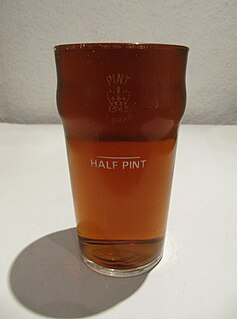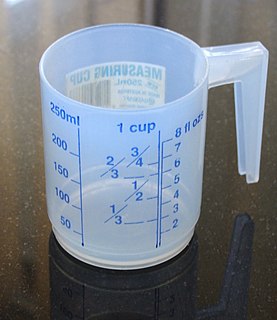
The system of imperial units or the imperial system is the system of units first defined in the British Weights and Measures Act of 1824, which was later refined and reduced. The Imperial units replaced the Winchester Standards, which were in effect from 1588 to 1825. The system came into official use across the British Empire. By the late 20th century, most nations of the former empire had officially adopted the metric system as their main system of measurement, although some imperial units are still used in the United Kingdom, Canada and other countries formerly part of the British Empire. The imperial system developed from what were first known as English units, as did the related system of United States customary units.

The litre or liter is an SI accepted metric system unit of volume equal to 1 cubic decimetre (dm3), 1,000 cubic centimetres (cm3) or 1/1,000 cubic metre. A cubic decimetre occupies a volume of 10 cm×10 cm×10 cm and is thus equal to one-thousandth of a cubic metre.

The tonne, commonly referred to as the metric ton in the United States and Canada, is a non-SI metric unit of mass equal to 1,000 kilograms or one megagram. It is equivalent to approximately 2,204.6 pounds, 1.102 short tons (US) or 0.984 long tons (UK). Although not part of the SI, the tonne is accepted for use with SI units and prefixes by the International Committee for Weights and Measures.

The metric system is an internationally recognised decimalised system of measurement. It is in widespread use, and where it is adopted, it is the only or most common system of weights and measures. It is now known as the International System of Units (SI). It is used to measure everyday things such as the mass of a sack of flour, the height of a person, the speed of a car, and the volume of fuel in its tank. It is also used in science, industry and trade.

In recipes, quantities of ingredients may be specified by mass, by volume, or by count.

The pint is a unit of volume or capacity in both the imperial and United States customary measurement systems. In both of those systems it is traditionally one-eighth of a gallon. The British imperial pint is about 20% larger than the American pint because the two systems are defined differently. Almost all other countries have standardized on the metric system, so the size of what may be called a pint varies depending on local custom.
The quart is an English unit of volume equal to a quarter gallon. It is divided into two pints or four cups. Historically, the exact size of the quart has varied with the different values of gallons over time and in reference to different commodities. Presently, three kinds of quarts remain in use: the liquid quart and dry quart of the US customary system and the imperial quart of the British imperial system. All are roughly equal to one metric litre.

A bushel is an imperial and US customary unit of weight or mass based upon an earlier measure of dry capacity. The old bushel was equal to 2 kennings (obsolete), 4 pecks or 8 dry gallons and was used mostly for agricultural products such as wheat. In modern usage, the volume is nominal, with bushels denoting a mass defined differently for each commodity.

A barrel is one of several units of volume applied in various contexts; there are dry barrels, fluid barrels, oil barrels and so on. For historical reasons the volumes of some barrel units are roughly double the volumes of others; volumes in common usage range from about 100 to 200 litres. In many connections the term "drum" is used almost interchangeably with "barrel".
A system of measurement is a collection of units of measurement and rules relating them to each other. Systems of measurement have historically been important, regulated and defined for the purposes of science and commerce. Systems of measurement in use include the International System of Units (SI), the modern form of the metric system, the imperial system, and United States customary units.

Metrication in Canada began in 1970 and while Canada has converted to the metric system for many purposes, there is still significant use of non-metric units and standards in many sectors of the Canadian economy. This is mainly due to historical ties with the United Kingdom, the traditional use of the imperial system of measurement in Canada, proximity to the United States, and to public opposition to metrication during the transition period.

The cup is a unit of volume, most commonly associated with cooking and serving sizes. It is traditionally equal to half a liquid pint in US customary units but is now separately defined in terms of the metric system at values between 1⁄5 and 1⁄4 of a litre. Because actual drinking cups may differ greatly from the size of this unit, standard measuring cups are usually used instead.
Arroba was a Portuguese and Spanish custom unit of weight, mass or volume. Its symbol is @.
The almude or cântaro is an obsolete Portuguese unit of measurement of volume used in Portugal, Brazil and other parts of the Portuguese Empire. An almude was equivalent to 6 potes or 12 canadas. In Spain, the unit was called almud and it was much smaller.
The arrátel was the base unit of weight in the Portuguese customary measurement system. Until the adoption of the metric system in the 19th century, the arrátel was used in Portugal, Brazil and other parts of the Portuguese Empire.

The metric system was developed during the French Revolution to replace the various measures previously used in France. The metre is the unit of length in the metric system and was originally based on the dimensions of the earth, as far as it could be measured at the time. The litre, is the unit of volume and was defined as one thousandth of a cubic metre. The metric unit of mass is the kilogram and it was defined as the mass of one litre of water. The metric system was, in the words of French philosopher Marquis de Condorcet, "for all people for all time".
A number of units of measurement were used in Paraguay to measure quantities including length, mass, area, capacity, etc. Metric system had been optional since 1890, and adopted since 1899 in Paraguay.
Moio, older spelling: Moyo, also as Mojo was a unit of measurement that measured grain and liquid used in Portugal and its colonies and in Brazil. The moio has small measurement differences below the alqueire. In case of grain and salt, the moio was used.










